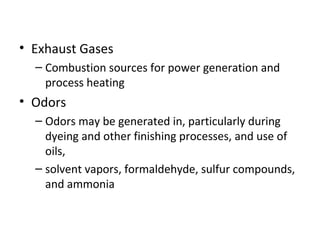Textile Industries And Environment(Specially For bangladesh)
- 1. Daffodil International university Md.Mohit-ul Alam ID:131-23-3384 SEC:C DEPT:TE
- 4. Textiles and the environment Textiles products have a large impact on the environment as energy and resources are used in production, and waste is produced
- 5. The textile industry • One of the major contributors to many Asian economies and one of the main revenue- generating sectors. • Has grown over the past years to become primary export earner and largest single employer of the manufacturing industry in Bangladesh
- 6. The textile industry • Comprised of a diverse, fragmented group of establishments that produce and or process textile-related products (fiber, yarn, fabric) for further processing into apparel, home furnishings, and industrial goods. • Receive and prepare fibers; transform fibers into yarn, thread, or webbing; convert the yarn into fabric or related products; and dye and finish these materials at various stages of production
- 7. The textile industry • Environmental issues – Wastewater – Emission to air – Energy consumption – Solid and liquid waste – Hazardous material management
- 8. • Industrial process wastewater from natural fiber processing • May contain pesticides used in pre-finishing processes (e.g. cotton growing and animal fiber production), • potential microbiological pollutants (e.g. bacteria, fungi, and other pathogens) • Other contaminants (e.g. dye, tar).
- 9. • Process Wastewater Treatment • wastewater treatment may require the use of unit operations specific to the manufacturing process in use. • source segregation and pretreatment of wastewater streams • (i) high load (COD) streams containing non- biodegradable compounds using chemical oxidation • (ii) reduction in heavy metals using chemical precipitation, coagulation and flocculation, etc. • (iii) treatment of highly colored or high TDS streams using reverse osmosis.
- 10. • Emissions to Air – Dust • occur during natural fiber and synthetic staple processing and yarn manufacturing. • Fiber (especially cotton) handling and storage are sources of dust, particularly within work areas. – VOCs and Oil Mists • Emissions of VOCs are related to the use of organic solvents in activities such as printing processes, fabric cleaning, wool scouring and heat treatments
- 11. • Exhaust Gases – Combustion sources for power generation and process heating • Odors – Odors may be generated in, particularly during dyeing and other finishing processes, and use of oils, – solvent vapors, formaldehyde, sulfur compounds, and ammonia
- 13. • Solid Wastes • include trials, selvedge, trimmings, cuttings of fabrics, and yarns; spent dyes, pigments, and printing pastes; and sludge from process wastewater












